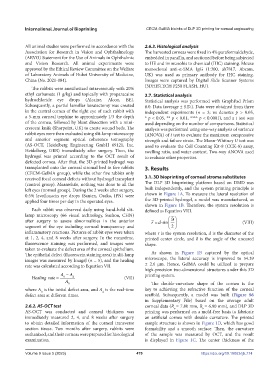Page 487 - IJB-9-5
P. 487
International Journal of Bioprinting CECM-GelMA bioinks of DLP 3D printing for corneal engineering
All animal studies were performed in accordance with the 2.6.3. Histological analysis
Association for Research in Vision and Ophthalmology The harvested corneas were fixed in 4% paraformaldehyde,
(ARVO) Statement for the Use of Animals in Ophthalmic embedded in paraffin, and sectioned before being subjected
and Vision Research. All animal experiments were to HE and immunohis to chemical (IHC) staining. Mouse
approved by the Ethical Review Committee on the Welfare monoclonal anti-α-SMA IgG (1:300, ab7817, Abcam,
of Laboratory Animals of Hubei University of Medicine, UK) was used as primary antibody for IHC staining.
China (No. 2021-084). Images were captured by Digital Slide Scanner Systems
The rabbits were anesthetized intravenously with 20% (3DHISTECH P250 FLASH, HU).
ethyl carbamate (1 g/kg) and topically with proparacaine 2.7. Statistical analysis
hydrochloride eye drops (Alcaine, Alcon, BE). Statistical analysis was performed with GraphPad Prism
Subsequently, a partial lamellar keratectomy was created 8.0. Data (average ± S.D.). Data were obtained from three
in the central cornea of the right eye of each rabbit with independent experiments (n = 3; ns denotes p > 0.05,
a 5-mm corneal trephine to approximately 1/3 the depth * p < 0.05, ** p < 0.01, **** p < 0.0001), and a t test was
of the cornea, followed by blunt dissection with a mini- used depending on the number of comparisons. Statistical
crescent knife (Sharpoint, UK) to create wound beds. The analysis was performed using one-way analysis of variance
rabbit eyes were then evaluated using slit-lamp microscopy (ANOVA) of t test to evaluate the maximum compressive
and anterior segment optical coherence tomography strength and failure strain. The Mann‒Whitney U test was
(AS-OCT, Heidelberg Engineering GmbH 69121, Inc. used to evaluate the Cell Counting Kit-8 (CCK-8) assay,
Heidelberg, GER) immediately after surgery. Then, the swelling ratio, and water content. Two-way ANOVA used
hydrogel was printed according to the OCT result of to evaluate other properties.
defected cornea. After that, the 3D-printed hydrogel was
transplanted onto the corneal stromal bed in five rabbits 3. Results
(CECM-GelMA group), while the other five rabbits only
received focal corneal defects without hydrogel transplant 3.1. 3D bioprinting of corneal stroma substitutes
(control group). Meanwhile, nothing was done to all the The DLP 3D bioprinting platform based on DMD was
left eyes (normal group). During the 2 weeks after surgery, built independently, and the system printing principle is
0.5% levofloxacin eye drops (Santen, Osaka, JPN) were shown in Figure 1A. To measure the lateral resolution of
applied four times per day in the operated eyes. the 3D-printed hydrogel, a model was manufactured, as
shown in Figure 1B. Therefore, the system resolution is
Each rabbit was observed daily using hand-held slit- defined as Equation VIII.
lamp microscopy (66 visual technology, Suzhou, CHN)
after surgery to assess abnormalities in the anterior r sin (VIII)
d
segment of the eye including corneal transparency and 2
inflammatory reactions. Pictures of rabbit eyes were taken where r is the system resolution, d is the diameter of the
at 1, 2, 4, and 8 weeks after surgery. In the meantime, printed center circle, and ϑ is the angle of the uncured
fluorescence staining was performed, and images were shape.
taken to evaluate the defect area of the corneal epithelium.
The epithelial defect (fluorescein staining area) in slit-lamp As shown in Figure 1B captured by the optical
images was measured by ImageJ (n = 5), and the healing microscope, the lateral accuracy is improved to 54.39
rate was calculated according to Equation VII. ± 2.6 μm. Hence, GelMA could be utilized to prepare
high-precision two-dimensional structures under this 3D
A A printing system.
Healing rate 0 d (VII)
A 0 The double-curvature shape of the cornea is the
where A is the initial defect area, and A is the real-time key to achieving the refractive function of the corneal
0
d
defect area at different times. scaffold. Subsequently, a model was built (Figure S6
in Supplementary File) based on the average adult
2.6.2. AS-OCT test corneal data (R = 7.80 mm, R = 6.80 mm), and DLP 3D
b
a
AS-OCT was conducted and corneal thickness was printing was performed on a mold-free basis to fabricate
immediately measured 2, 4, and 8 weeks after surgery an artificial cornea with double curvature. The printed
to obtain detailed information of the corneal transverse sample structure is shown in Figure 1D, which has good
section tissue. Two months after surgery, rabbits were formability and a smooth surface. Then, the curvature
euthanized, and their corneas were prepared for histological of the sample was measured by OCT, and the result
examination. is displayed in Figure 1C. The center thickness of the
Volume 9 Issue 5 (2023) 479 https://doi.org/10.18063/ijb.774

